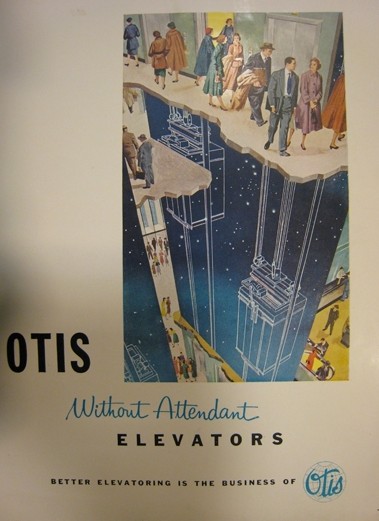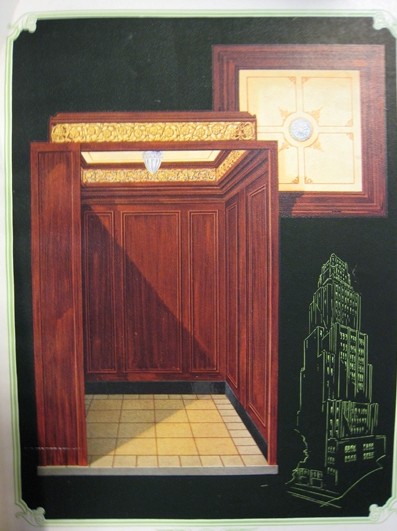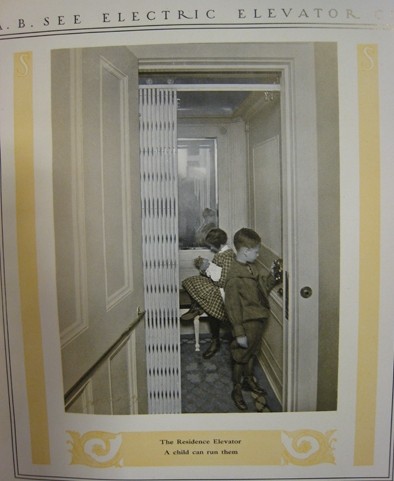anth g6085

the elevator
audrey boguchwal (columbia university)
As city dwellers, elevators pervade our lives. Elevators carry us upwards to the top of tall buildings and down beneath the street to subterranean movie theatres, trains and shopping concourses. They enabled the construction of skyscrapers and shape their floorplans, they facilitate dense urban development, and we entrust them with our lives – and yet, for all these notable qualities, they are designed so that when they are functioning properly, we barely notice them. The elevator is a concrete material object whose ideal – but unachievable – functionality is to be immaterial.
 .........
.........
The elevator is a machine, and like many complex machines, it is a collection of objects, of moving parts and computerized bits and bytes that all work in concert to make a unified whole whose functionality is different than that of most of its component parts. An elevator is simply a platform or compartment attached to a lifting pulley system.
While hoists date back to medieval grain lifts, the passenger elevator was distinguished by the invention of the safety break in the mid nineteenth century. Elisha Otis invented a breaking mechanism which he exhibited at the 1853 New York World’s Fair. Otis famously stood atop a hoist elevator in the middle of the hall and cut the supporting cable while onlookers watched in awe. The safety device fixed the platform to the elevator frame and ensured that elevator would not fall down the shaft in the event of an accident. Otis invention is the key development in technology that made elevators safe for people. Otis went on to found the Otis Elevator Company, based in Westchester County and now owned by UTC. The same hoisting technology used in elevators is also employed in dumbwaiters (small lifts for freight) and cranes used for constructing tall buildings.
Early passenger elevators in the late nineteenth century were first used in hotels, some private homes, and department stores. The first elevator in New York was installed in the now-defunct Fifth Avenue Hotel; the first office building to have one was the Haughwout building, still standing in Soho.
The earliest elevators functioned by means of a pulley system, later they invoked steam power, hydraulics and eventually electric means of transporting passengers. All of these technologies required an operator to either pull the rope or throw a lever and open the door. These elevators generally also had a cage design, meaning that passengers could see the shaftway and building from within the elevator. It was not an isolated room and passengers had much more of a sense of movement within the building and an awareness of the functionality of the machinery. Furthermore, the elevator moved because the operator put it in motion. Its travels up and down the building were clearly a result of the operator’s agency. The operator was a communicator – translating the desires of the passenger into a language that the elevator, and therefore, the building, could understand.
Elevators also create an environment of shared physical space. It is not a delineation between public and private (already a fuzzy distinction), but one of communal usage. The elevator fostered a temporary relationship between people whose only commonality was often the need to use the elevator at a certain time. Thus, elevators force certain etiquette rules. Do you greet the other passengers? If so, do you greet them verbally? Do you make eye contact? Who has temporary ownership of what space within the confines of the elevator? In the nineteenth century, separate elevators were operated for men and women because it was considered improper for a woman to be alone in a room with a man – and the elevator constituted a room. Oddly enough, the elevator operator (often male in the nineteenth century) was not considered in these plans. Elevator operators were seen as part of the machinery, a viewpoint which acquired racial tinges in the twentieth century as many of them were of African American descent.

Innovations of the mid twentieth century changed the relationship between passengers and elevators. The elevator became simple enough for children to operate. Automatic push buttons, automatic doors with an electric “eye” to sense movement, enclosed cars and signal control systems transformed the elevator from a device driven by a person to a robot that functions with seeming autonomy. Still, for all its automatic motion, elevators respond to human instruction by answering calls inputted through their buttons. Its movements are a product of collected individual will as it responds to calls throughout the building.
With their lack of operators and automatic movements, the elevator space also became fetishized. It is an empty box of non-space that does not belong to any floor in the building, or any person – and yet can be used by anyone and can be found on every floor. It became a place of fantasy, where anything could happen (hence Aerosmith’s song “Love in an Elevator”) – perhaps because it is most often a boring, silent place.
In typical elevators today, the car is raised by motor-driven wire ropes that are attached to the top of the car at one end, travel around a pair of sheaves, and are again attached to a counterweight at the other end. The counterweight adds accelerating force when the car is ascending and provides a slowing effort when the car is descending so that less motor horsepower is required. Guide rails that run the length of the shaft keep the car and counterweight from swaying or twisting during their travel. Rollers are attached to the car and the counterweight to provide smooth travel along the guide rails. The main sheave is driven by an electric motor. As the car approaches its destination, a switch near the landing signals the controls to stop the car at floor level.
For all of this complex and sophisticated technology, the best elevators are the ones we notice the least. They transport us safely and efficiently to our destinations and we rarely think about them. It is only when an elevator is broken, or too slow or too fast that it becomes present in our lives. What is the materiality of a complex device designed to blend into the background? The manufactures and advertisers on the Captivate Ad Network that appears in many office building elevators would love people to pay more attention to their surroundings during their elevator rides. I would like to argue that in urban centers like New York, Dubai, Hong Kong and Shanghai, the elevator has become immaterial and thus allowed us to construct our lives around and over it. It only becomes material again when it malfunctions and then we notice how the elevator supports the infrastructure of our lives and it becomes evident how much we rely on them. To illustrate this point, I would like to present a brief vignette about the elevator in my apartment building and how it shapes my life.
I live in a converted warehouse building with a manually operated elevator. (We all compromise on something when it comes to housing in New York). My building does not have an operator and the residents take turns operating it ourselves. It is a cage elevator controlled by a lever and the doors are a screen and a sliding shaftway door. Recently, it was sporadically broken for a month. I live on the 8th floor of my building and I spent much of that month apologizing to guests who had to climb the stairs, avoiding grocery shopping, developing excellent quad muscles, likely damaging my knees, and talking about the elevator to my roommates, neighbors and anyone who would listen. By malfunctioning, the elevator shaped my social interactions, consumption habits, and even my body in very tangible ways.
I was unsure which authors and texts to invoke when thinking about the immateriality of the elevator experience. I do not believe that the vanishing of the elevator is a fetishist experience – although its space may be – nor is it a question, like Ingold’s, of where the materials themselves become materiality. Rather, I believe that it is a question of when an immaterial experience slips below the surface of consciousness and becomes undetectable all together. The motion of the elevator is already hidden away, its intricate technology somewhere behind the veil of the car, its dangerous heights tamed beneath breaks and noises stifled by mufflers. When one emerges onto a windowless office floor, what, aside from perhaps the inner ear’s sense of motion, is there to tell you that you have traveled at all? Or gone up instead of down? What is the materiality of an object that tries to make us forget it is even there? I am tempted to agree with Miller’s words in the introduction to Materiality, when he asserts that, “the very clarity within this mission towards immateriality brings out the inherent contradiction that follows from the impossibility of ever transcending the process of objectification itself,” thus making the elevator a sort of temple, a religious experience.[1] If the elevator is an object, then how can it create an immaterial experience?
There is also the issue of the elevator’s agency. In a very Latourian sense, the elevator moves independently. It responds to calls, decides what floors to service first, and in certain cases, simply moves on its own so that people do not have to even input directions (“Sabbath” elevators stop at every floor in a building. They are designed for use by religious Jews who do not use electricity on religious days.) However, the programs must be set in motion. They must be written and inputted by people and most importantly, they require people to fix them when they malfunction. I find Tim Ingold’s response to the notion of machines making history compelling, as set out in his essay “Tools, minds and machines,” in The Perception of the Environment. His final conclusion that they have been made by history, supports my point that elevators do not have agency.
I have discussed the ways in which the elevator is a machine that both shapes and has been shaped by human life. The development of the passenger elevator throughout the past one hundred and fifty years demonstrates the need for upward human transport. The density of business and daily life in urban centers created the need for taller buildings and elevators were a key factor in facilitating their evolution. Although the elevator shapes modern city life, its desired function is to be immaterial and invisible – an unnoticeable ideal that is never quite achieved. While it appears to have agency, its motions are still the extensions of human actions. It is still, quite simply, an object acted upon by subjects.
works cited
Materiality, edited by Daniel Miller. Durham, NC: Duke University Press, 2005.
From Ascending Rooms to Express Elevators: A History of the Passenger Elevator in the Nineteenth Century. By Lee E. Gray. Mobile, Ala.: Elevator World, Inc., 2002.
Ingold, Tim. “Tools, minds and machines: an excursion in the philosophy of technology.” In The Perception of the Environment: Essays in Livelihood, Dwelling and Skill, pp. 294-311. Routledge, London. 2000.